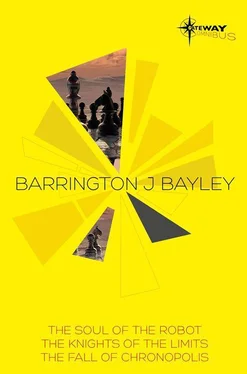Instead, the Hegemonics must have used their most terrible weapon, of which the High Command had obtained some information but which they had never been absolutely sure existed: a time-distorter, capable of altering the fabric of time directly. Gerread had been simply… annulled. All trace of it, past and future, had vanished.
It was a sobering thought that in all probability no one except those aboard the ships manoeuvring in the strat, and those in the special Achronal Archives at Chronopolis, had even heard of Gerread any more. Once again Haight experienced the familiar burden: the terrible responsibility of being a chronman.
The priest, having finished his asperges, retired to the rear of the bridge, where he learned the dreadful facts confronting Haight and Anamander. He began to pray in a sonorous, desperate mutter. The two officers shared his feeling of horror: Gerread and all its inhabitants had been swallowed, foundering like a ship, by the infinity of nonactual, merely potential time. That, at least, was how it was described technically. In church language it was the Gulf of Lost Souls.
Leaving behind it a clap of air, the flagship rephased into the substratum. Haight recalled the region of turbulence they had recently passed through. That, no doubt, had been connected with the new distortion in the orthogonal time-flow. But the battle was not yet lost. There was still strat time, and in strat time events did not vanish, once having taken place, but lingered for hours, days, sometimes months of subjective personal time. Nothing was irreversible.
They might yet snatch back those lost souls from perdition.
The fleet continued its traverse. This, Haight reminded himself, was but a preliminary exercise in how the coming time-war would be fought. Always the object would be to alter the adversary’s history: reaching back and further back into the murky tale of mutated events, answering every move with a cancelling counter-move. And final victory would be achieved only when the history of one side was so completely distorted that the existential support for its fleets of timeships was removed. Even then they would continue to fight for a while, ghosts moving through the strat, never having been manufactured, manned by crews that had never been born. Then they would fade, sinking into nonactual, potential existence.
But it was some time before the warning gong sounded again and Hegemonic ships came up once more on the scope screen.
‘Heading for Node Five,’ the scanman informed him.
They counted the ships as they appeared blurrily on the screen. There were twelve.
‘This is it,’ Haight said. ‘This is their incoming path. Get ready.’
Captain Mond Aton, officer commanding the Smasher of Enemies , had seen the Hegemonics’ outgoing flight path on the scope screen of his own ship and had fully expected to enter battle. Only later, when the order to hold came from the flagship, did he realise that he had been impetuous. The homeward-bound ships would probably have refused to fight; and even if defeated, their destruction would solve nothing.
His own bridge was a miniature of Commander Haight’s; it was manned by only seven men. Unlike the bigger, heavier ships that doubled as battleships and troop carriers, the Smasher of Enemies was a manoeuvrable, lightly manned, heavily armed destroyer. It had the speed to pursue, and elaborate chronphase equipment for accurate microsecond broadsides.
‘Breaks your heart to see them go,’ said the scanman, looking up from the screen, ‘doesn’t it, sir?’
Aton nodded. ‘They haven’t escaped us yet, Scanman. Those ships we see are already ghosts, though they don’t know it.’
The wedge-shaped Hegemonics faded. Aton did not think too deeply about the paradoxes involved in what he had said. In the strat paradoxes were commonplace. And not only in the strat, either: since the rise of the Chronotic Empire every lowly citizen had been made aware of how contingent his existence was on the fickle mutability of time. Many were the millions who, having existed once ( once , if that word were to be given a meaning outside time altogether), now ceased ever to have existed. Outside, that is, the roll of nonexisting citizens in the Achronal Archives, which contained more history that had disappeared than it did extant history.
Unless the Hegemonic attack could be stopped, many millions more would be added to that roll.
Aton turned to Lieutenant Krish.
‘Hold the bridge for me. I’m going to make a quick check.’
As he left the bridge and walked through the galleries he could feel the tension building up in the ship. This would be his third sizeable engagement and on each of the others he had liked to visit each section under his command beforehand. It gave him a feeling of integrating the vessel into a tight fighting unit. And it would be a good half-hour, he told himself, before the fleet found its quarry.
He visited the gunnery-room, where tension was, of course, at the highest pitch – and no wonder. His glance swept around the computer terminals, of which the men themselves were in a sense mere appendages. In some ships gunnery was on the bridge itself, which at first sight seemed a logical arrangement, if cumbersome. But Aton preferred it this way, although he knew some captains did not.
After a few words of encouragement to his gunners he went deeper into the ship to the drive-room.
He paused outside the door at the sound of voices, then smiled to himself. Ensign Lankar, a keen young engineer but newly inducted into the Imperial Time Service, was loudly displaying his knowledge to a drive-room assistant in his charge.
‘The time-drive is really based on the good old mass-energy equation,’ Lankar was saying. ‘E equals MC squared. Let’s take one of the factors on the right-hand side of this equation: C squared. That’s where time comes in. C is the velocity of light – the distance per time of an otherwise mass-less particle. So energy is really mass multiplied by time squared. But we can also write the equation this way: M equals E over C squared. This shows us that mass is a relationship between energy and time. So now we’re getting somewhere: what happens if we disturb this relationship? We do this by forcing energetic particles to travel faster than light. And now we find that the equation doesn’t balance any more: energy divided by the velocity of light squared no longer adds up to rest mass. But the equation must balance – it’s a fundamental physical law. So what happens? The equation keeps the scales even by moving rest mass through time, to the same extent that the time factor is transgressed on the right-hand side.’
‘But where does the strat come in, Ensign?’
‘The strat is what time is made of, lad. If you move through time, that’s what you have to move through.’
Ensign Lankar thumped the steel casings that bulged into the drive-room. ‘And here’s where it’s all done. This is where we accelerate pi-mesons to anything between C and C squared. It’s the most important part of the whole ship, and don’t you forget it.’
Lankar’s voice sounded incongruously young as he talked self-consciously down to his underling. ‘M equals E over C squared,’ he repeated. ‘Notice that time is involved in both elements on the right-hand side. That’s why pure energy can’t be transmitted through the strat, only mass. So we have no radio communication with the High Command and have to use the couriers, poor devils.’
Both young men jumped up with embarrassment and saluted hastily as Aton entered. They had been seated on wooden benches well away from the main control desk, where the drive-room’s senior staff were too busy for such idle talk.
‘Everything in order?’ Aton called gruffly, speaking over the high-pitched whine that always infected the drive-room.
Читать дальше












